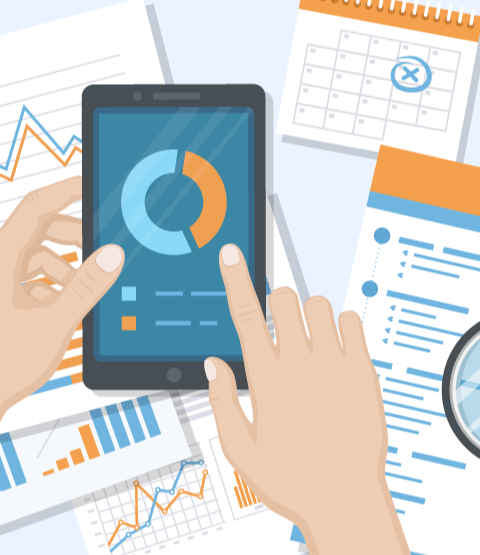Share this
Team Utilization 101: Tracking Team Utilization Rate
by Jarno Koopman on February 7, 2023

The predominant company culture in the professional services world these days centers around the essence of team.
Teams are not machines; they’re well-oiled systems of talented and responsible people that work together to make the business work. When it’s all about the team, you want to make sure you’re placing the right people together in the right situations, both to maximize profitability and to maintain flow. Managers and owners also want to utilize their teams as much as they can. That translates into keeping productivity high and leveraging all the talents and experience the team has to offer. To determine your team's productivity and profitability, you’ll need to measure team utilization.
You can increase your team’s efficiency by effectively managing your team utilization over time, which can be accomplished relatively easily with accurate data and the fortitude to make decisions with the information. In Team Utilization 101, we’ll run through the basics of what you need to calculate your team’s utilization rate, and we’ll touch on how to manage it as your business scales.
Why is tracking team utilization essential?
When you’re managing one or more teams, you don’t just want to see how productive and efficient each individual is. This is called the individual employee utilization rate. It’s part of the metrics for figuring out your team utilization, but it’s only concerned with individuals. In team-based organizations, you want to get a sense of how your teams are performing as a whole.
Enter team utilization.
Tracking your team utilization will help you see how much time is being spent on client-facing work versus non-billable hours. You’ll gain important insights into your team’s workflows: How are people actually spending their time while working? How is the work flowing? Where is the demand highest? Where are there productivity lulls and spikes? It can be difficult to answer those questions without solid data, which is where calculating your team utilization comes in.
If you’re not tracking your team’s utilization, you might be losing money, or at the least, your project profitability may be lower than it should be.
What is a utilization rate?
In a nutshell, a utilization rate measures a person or team’s work hours against their total capacity. There are a couple of different utilization rates, all expressed as percentages, that together, paint the most accurate picture:
Employee utilization rate
This is the old-school method that’s more relevant now to measure the productivity of salaried employees. Employee utilization rate equals total work hours divided by capacity.
Total Work Hours / Capacity
Billable utilization rate
Billable utilization measures how billable a person or team is by dividing their billable hours divided by their total capacity. Billable utilization rates can help you see how much time is being spent on billable versus non-billable work.
Billable Hours / Capacity
How do you measure team utilization?
You can measure your team’s utilization simply by using utilization rates. These figures are based on time tracking data and capacity data and are expressed as a percentage. To measure your team utilization, you can do a few quick calculations or use your billable hours software that has these metrics built in. Here’s a simple formula to measure team utilization:
Team Billable Hours / Team Capacity
You can measure team utilization within any time frame you’d like. You can figure out team utilization on a project basis to zero in on project profitability. Or if you’re a service business in IT, for example, you can measure utilization and profitability on a customer basis that follows what’s in your service agreement.
Here’s an example of measuring team utilization:
Let’s say you have a team of 4 whose utilization you want to measure over a month-long period. Team member A has a total of 80 billable hours against a total capacity of 100 hours for the month. Team member B has a total of 60 billable hours against their total capacity of 65 hours for the month. Team member C has a total of 80 billable hours against a total capacity of 90 hours for the month. Last, team member D has a total of 75 billable hours and a total capacity of 100 hours.
Remember: Billable Utilization = Billable Hours / Capacity (x 100%)
|
Billable Hours |
Capacity |
Billable Utilization |
|
|
Team member A |
80 |
100 |
80% |
|
Team member B |
60 |
65 |
92% |
|
Team member C |
80 |
90 |
89% |
|
Team member D |
75 |
100 |
75% |
|
TEAM TOTAL |
295 |
355 |
83% |
In this example, the team utilization rate overall is solid at 83%. In professional services, the low 80s are usually a good thing.
We can also see that some team members are more billable than others, aka their utilization rate is higher. Team members B and C show high levels of productivity and efficiency with utilization rates in the low 90s and high 80s, respectively. Team member A also makes good use of their time at work with a good utilization rate of 80%. But while this table would clearly show a project manager that the team is productive with their time, we can see that team member D is lagging slightly with a 75% billable utilization rate.
How do you manage team utilization?
You can manage your team utilization effectively by tracking utilization rates over time. This is something you can do yourself in an Excel spreadsheet. If you have software that tracks your team’s billable hours, you should be able to automate the process and see your team utilization as it’s happening. The software will aggregate all the time tracking and capacity data for you, so there’s really no legwork involved.
Team utilization reports & dashboards for the win
To stay on top of your team’s utilization and keep your profitability high, we recommend running a team utilization report. The above example we gave works as a basic utilization report, so it’s not a bad place to start. These reports aren’t complicated and clearly show owners, management, and team members themselves how everyone works both individually and as a team. You can create utilization reports in a couple of clicks with your billable hours software or resource management tool. Most will come with handy graphs to help you visualize the information.
Speaking of visualizing information, utilization dashboards are a big win for keeping productivity and profitability high. These are provided by the software you use to manage your billable hours. Utilization dashboards give you penetrating insight into your team’s billability at-a-glance with real-time data and analytics.
How to improve your team utilization rate
- Talk to your team
Communication is key. The best way to get your team utilization rate up is to talk to your team. If someone is falling a bit low with their individual billable utilization, ask about what’s going on in their life. Perhaps some people work better in certain environments and on certain tasks. Maybe a social rift is causing productivity to go down. Talk to your team to get the real inside scoop about how things are going.
- Figure out the deal with non-billable hours
What’s going on during all those non-billable hours? Is your time regularly wasting billable time on inter-office tasks? Maybe there’s a surplus of internal meetings that can be handled with a simple Loom video. Whatever is going on during non-billable time, find out what it is.
- Automate whenever you can
Automation can go a long way in shaving off non-billable time. If your team members are spending too much time on administrative work like invoicing and time tracking, for example, you can leverage automated invoicing that will automatically generate an invoice based on logged hours.
- Use billable hours software to track utilization
Instead of wasting your time on spreadsheets, you can use billable hours software to track your team’s utilization rate. Reports and dashboards can help you manage your team utilization by giving you constant visibility. Just a glance and a couple of clicks are all you have to do to get the information you need.
Share this
- Project Management (101)
- Productivity (63)
- Time Tracking (27)
- PSA Software (26)
- HubSpot (20)
- Resource Management (15)
- Invoicing (12)
- Salesforce (11)
- AI (10)
- Profitability (8)
- Contract Management (7)
- collaboration (5)
- Gantt Chart (4)
- Microsoft Dynamics (4)
- Budget Management (3)
- Consultancy (3)
- Financial services (3)
- Integrations (3)
- Quickbooks (3)
- Quote (3)
- ROI (3)
- Traffic Management (3)
- About PSOhub (2)
- Automation (2)
- Digital Marketing & Advertising (2)
- Pipedrive (2)
- Work Management (2)
- IT Companies (1)
- Product (1)
- Risk Management (1)
- Task Management (1)
- Ticket Sync (1)
- Workload Management (1)
- power bi (1)
- December 2025 (2)
- November 2025 (3)
- October 2025 (2)
- September 2025 (1)
- August 2025 (1)
- July 2025 (4)
- June 2025 (1)
- May 2025 (5)
- April 2025 (4)
- March 2025 (3)
- February 2025 (3)
- January 2025 (3)
- December 2024 (1)
- November 2024 (5)
- October 2024 (5)
- September 2024 (1)
- August 2024 (4)
- July 2024 (3)
- June 2024 (5)
- May 2024 (4)
- April 2024 (5)
- March 2024 (5)
- February 2024 (4)
- January 2024 (3)
- December 2023 (2)
- November 2023 (6)
- October 2023 (5)
- August 2023 (6)
- July 2023 (2)
- June 2023 (4)
- May 2023 (4)
- April 2023 (3)
- March 2023 (4)
- February 2023 (4)
- January 2023 (3)
- December 2022 (5)
- November 2022 (3)
- October 2022 (4)
- September 2022 (5)
- August 2022 (7)
- July 2022 (1)
- June 2022 (7)
- May 2022 (6)
- April 2022 (2)
- March 2022 (2)
- February 2022 (4)
- January 2022 (4)
- December 2021 (5)
- November 2021 (2)
- October 2021 (2)
- September 2021 (3)
- August 2021 (3)
- July 2021 (2)
- June 2021 (2)
- May 2021 (3)
- April 2021 (2)
- March 2021 (2)
- February 2021 (3)
- January 2021 (5)
- December 2020 (4)
- November 2020 (2)
- October 2020 (4)
- September 2020 (5)
- August 2020 (4)
- July 2020 (4)
- June 2020 (1)
- May 2020 (4)
- April 2020 (8)
- March 2020 (7)
- January 1970 (1)



